Friday Oct. 13, 2006!
Quiz #2 was returned in class today. The average grade was
79%. Be sure to carefully check the grading on your quiz.
Experiment #3 materials were distributed in
class today. A few
remaining sets of materials will be available for checkout in class
next week.
The Atmospheric Stability Worksheet (part of 1S1P Assignment #2a)
was handed out in class.
Now we
move to an important new topic: humidity. The beginning of
Chapter 4 can be a little overwhelming and confusing. If you find
it too confusing, I would suggest you stop reading and not worry
too much about it. Study the class notes and
once you feel comfortable with the material there you can go back and
read the beginning of Chapter 4.
A brief introduction to some of the humidity variables is given on p.
83 in the photocopied notes.
We will be mainly interested in 4 variables: mixing ratio, saturation
mixing ratio, relative humidity, and dew point.
What you find below is an
enhanced and expanded version of what we covered in class on Friday.
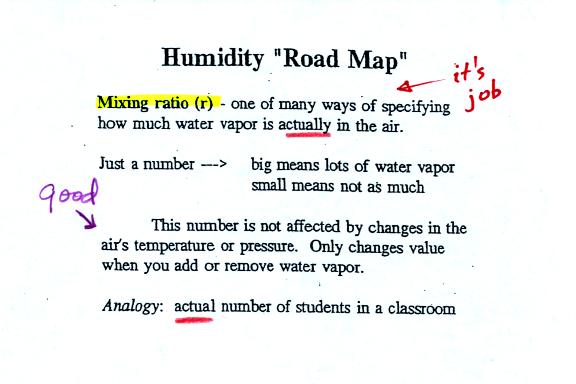
Mixing ratio tells you how much water vapor is actually in
the
air. Mixing ratio has units of grams of water vapor per kilogram
of dry air (how much water vapor in grams is mixed with a
kilogram
of dry air). It is basically the same idea as teaspoons of sugar
mixed in a cup of tea.
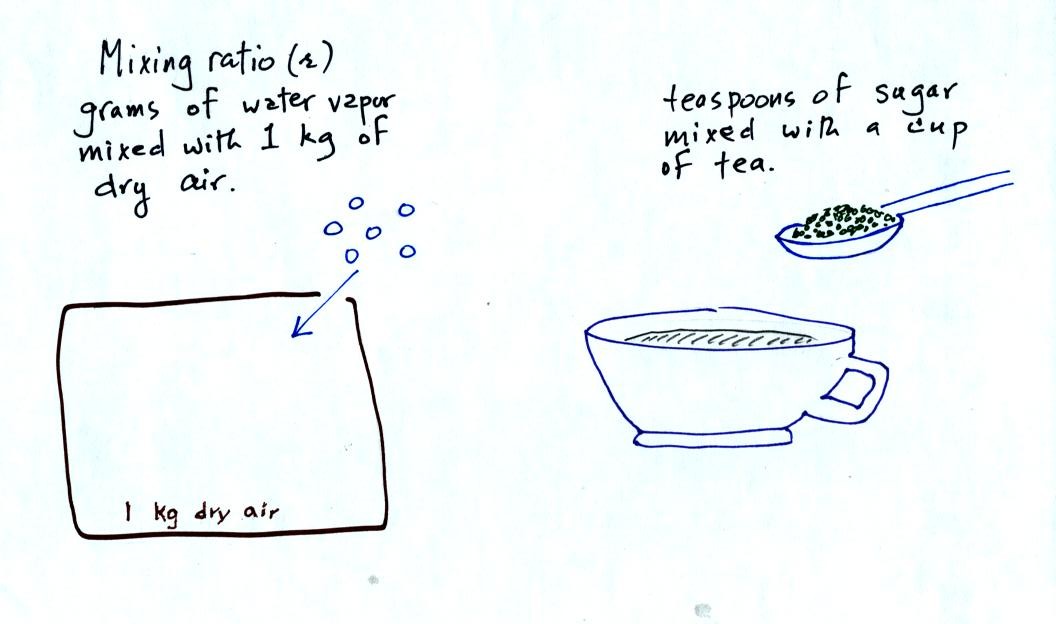

Saturation mixing ratio is just an upper limit to how much
water vapor
can be found in air. It doesn't say anything about how much water
vapor is actually in the air (that's the mixing ratio's job).
Warm air can potentially hold more water vapor than cold air.
This variable has the same units: grams of water vapor per kilogram of
dry air.
The dependence of saturation mixing ratio on air temperature is
illustrated below:

The small specks represent all of the gases in air except
for the water
vapor. Each of the open circles represents 1 gram of water vapor
that the air could hold. There are 15 open circles drawn in the 1
kg of 70 F air; each 1 kg of 70 F air could hold up to 15 grams of
water vapor. The 40 F air only has 5 open circles; this cooler
air can only hold up to 5 grams of water vapor per kilogram of dry air.

Now we have gone and actually put some water vapor into the
volumes of
70 F and 40 F air. 3 grams of water vapor have been added to each
volume of air. The mixing ratio, r, is 3 g/kg.
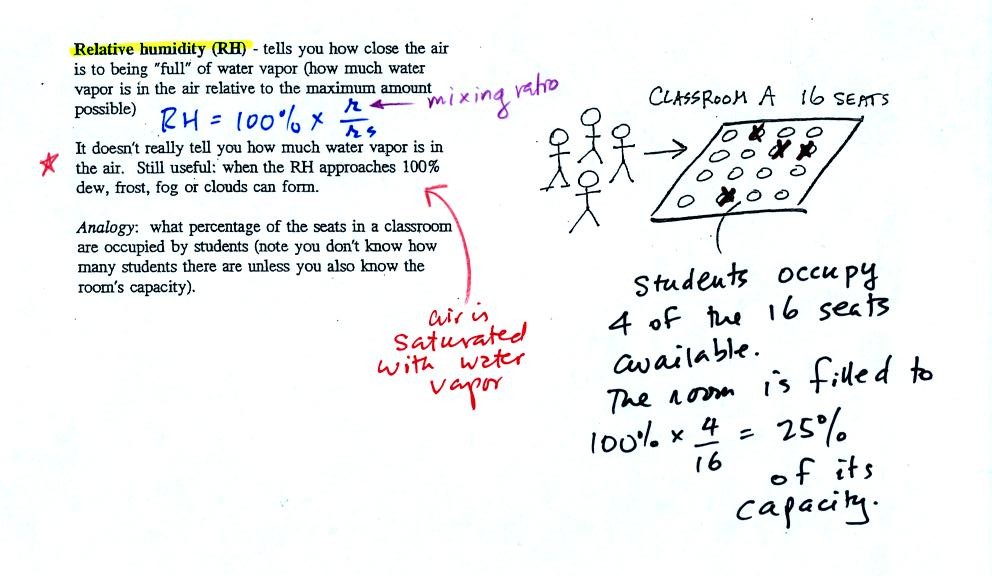 The relative
humidity tells you how "full" the air is with water
vapor.
In the analogy 4 students wander into Classroom A which has 16 empty
seats. Classroom A is filled to 25% of its capacity.
You can think of 4, the number of students, as being
similar to the mixing ratio. The classroom capacity is analogous
to the
saturation mixing ratio. Instead of students and a classroom you
could think of a kilogram of warm air that could potentially hold 16
grams of water vapor.
The relative
humidity tells you how "full" the air is with water
vapor.
In the analogy 4 students wander into Classroom A which has 16 empty
seats. Classroom A is filled to 25% of its capacity.
You can think of 4, the number of students, as being
similar to the mixing ratio. The classroom capacity is analogous
to the
saturation mixing ratio. Instead of students and a classroom you
could think of a kilogram of warm air that could potentially hold 16
grams of water vapor.

Here are the relative humidities of the 70 F and 40 F air that each
contain 3 grams of water vapor. The 70 F air has a low RH because
this warm air's saturation mixing ratio is large. The RH in the
40 F is higher even though it has the same actual amount of water vapor
because the 40 F air can't hold as much water vapor and is closer to
being saturated.
You can see how RH doesn't really tell you how much water vapor is
actually in the air. The two volumes of air above contain the
same amount of water vapor (3 grams per kilogram) but have different
relative humidities.
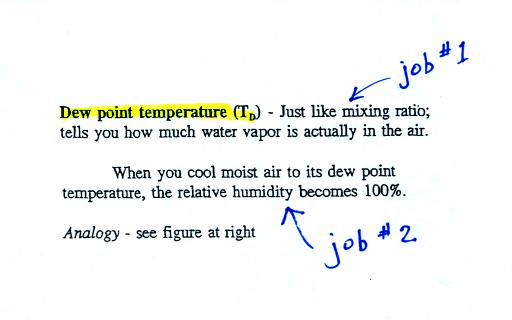
The dew point temperature has two jobs. First it is a
measure of
the actual amount of water vapor in the air. In this respect it
is just like the mixing ratio. If the dew point temperature is
low the air doesn't contain much water vapor. If it is high the
air contains more water vapor.
Second the dew point tells you how much you must cool the air in order
to cause the RH to increase to 100% (at which point a cloud, or dew or
frost, or fog would form).

If we cool the 70 F air or the 40 F air to 30 F we would
find that the
saturation mixing ratio would decrease to 3 grams/kilogram. Since
the air actually contains 3 g/kg, the RH of the 30 F air would become
100%. The 30 F air would be saturated, it would be filled to
capacity with water vapor. 30 F is the dew point temperature for
70 F air that contains 3 grams of water vapor per kilogram of dry
air. It is also the dew point temperature for 40 F air that
contains 3 grams of water vapor per kilogram of dry air.
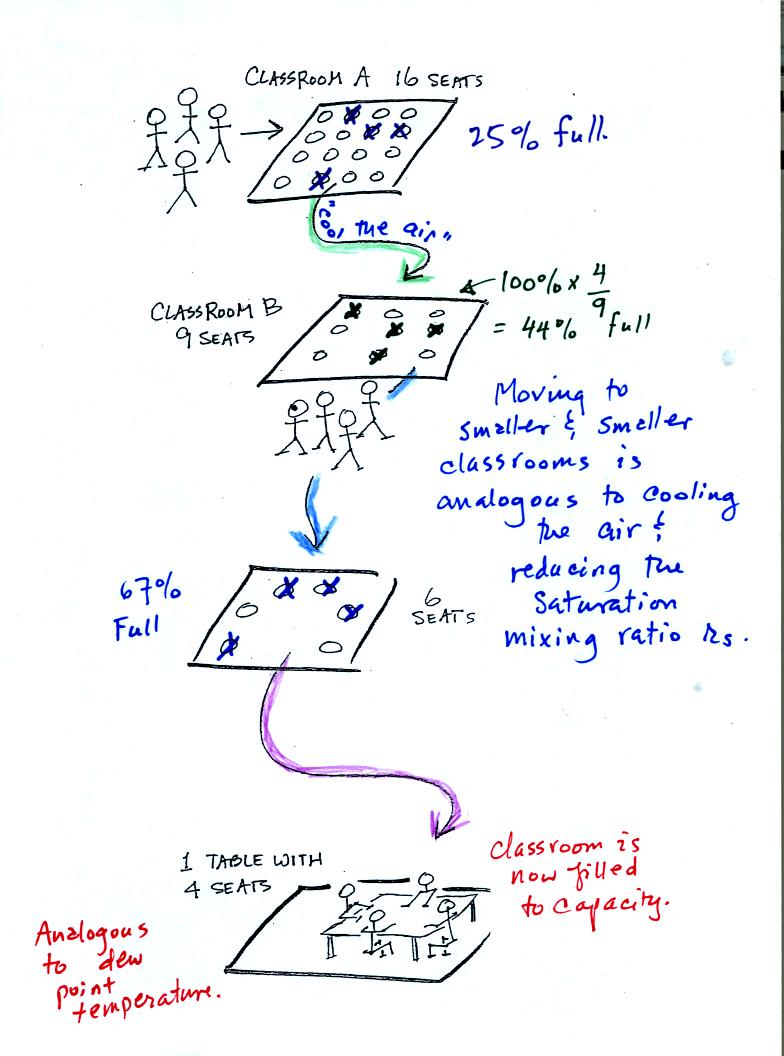
Now back to our students and classrooms analogy on the righthand
side of p. 83. The 4 students
move into classrooms of smaller and smaller capacity. The
decreasing capacity of the classrooms is analogous to the
decrease in saturation mixing ratio that occurs when you cool
air. Eventually the students move into a classroom that they just
fill to capacity. This is analogous to cooling the air to the dew
point temperature, at which point the RH becomes 100% and the air is
filled to capacity, the air is saturated with water vapor.
Next we
will try to understand better why it is possible to saturate air with
water vapor. Why is there an upper limit to the amount of water
vapor that air can contain. Why does this upper limit depend on
air temperature.
First we need to understand that the rate at which water evaporates
depends on the water's temperature.

To be able to evaporate a water molecule must make its way
up to the
surface of the water and the water molecule must have sufficient energy
to overcome any attractive forces trying to keep it in a liquid
state. In cold water only a limited number of the water molecules
have the necessary energy - cold water has a low rate of
evaporation. In hot water, a larger fracton of the water
molecules will have enough energy, hot water evaporates more rapidly.
Now we will look at the top part of p. 85 in the photocopied
notes. We have put a cover on the glass of room temperature
water.
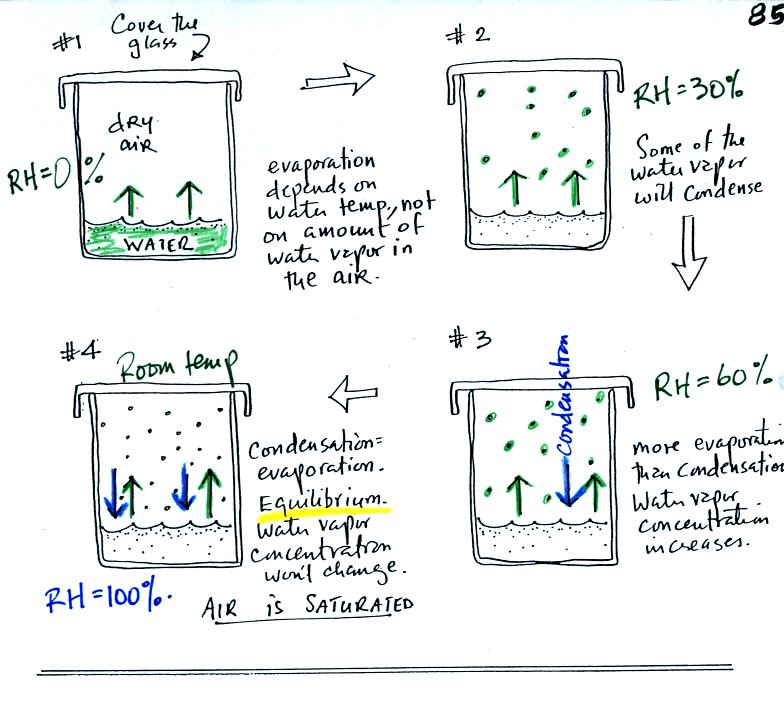
In #1 we see that the water is evaporating (2 arrows worth
of
evaporation). Water vapor will begin to build up in the air in
the glass. This is shown in #2. Some of the water vapor
molecules will condense (even though they may have just
evaporated). In Fig. #3 the amount of water vapor has built up to
a point where there is one arrow worth of condensation. In #3
there is still more evaporation than condensation so the water vapor
concentration will increase a little bit more. Eventually in #4
the water vapor concentration has increased to a point that there are
two arrows of condensation. This balances the 2 arrows of
evaporation. The air is saturated, the air is filled to
capacity. The amount of water vapor in the air will remain
constant.
What would happen if we took off the cover and added some
more water
vapor to the glass in Fig. #4? The figure below wasn't shown in class.
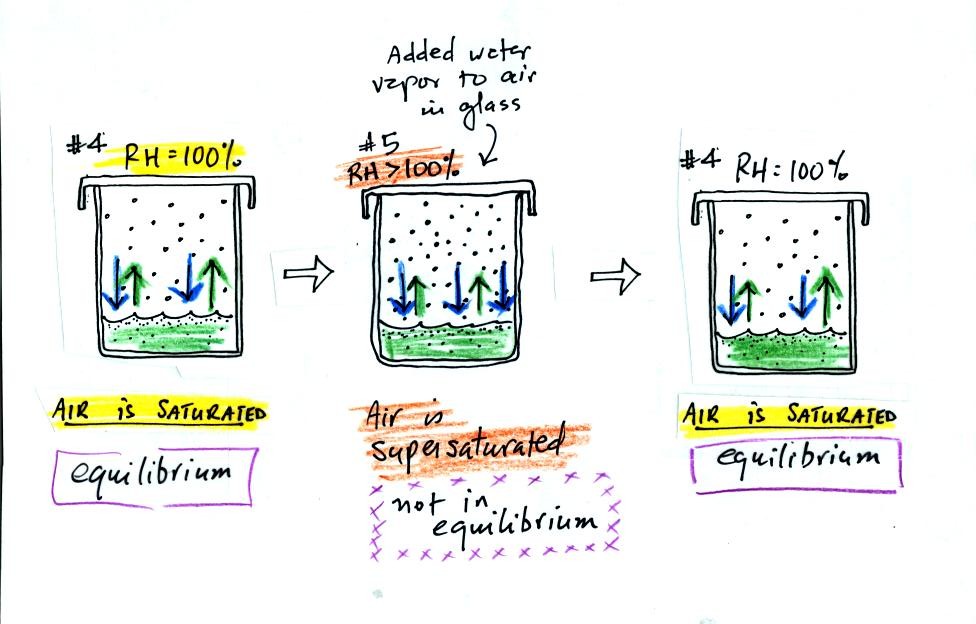
The air in Fig. #5 shows what would happen. The air
would be supersaturated with water vapor and the RH would be greater
than 100%. This is possible but it is not an equilibrium
situation. The increased amount of water vapor would increase the
rate of condensation. There would be more condensation than
evaporation. The water vapor concentration would begin to
decrease. Eventually the glass would end back at the equilibrium
situation in Fig. #4.
If we look at the bottom of p. 85 we see that the air in all
three cases is
saturated (equal rates of evaporation and condensation in each
case). The relative humidity is 100% in all three cases.
The amount of water vapor in the air however is different. The
warm air contains a lot more water vapor than the cold air.

This final
portion of the online notes was a brief introduction to Experiment #3.
The
two collectors below have been placed outside in the sunlight.
They have been tilted at just the right angle so that the rays of
sunlight strike them directly.

What does your intuition tell you? Would the larger collector
absorb MORE energy
than, LESS energy than, or the SAME amount of
energy as the smaller collector?
What about the following situation? Two collectors with the same
crossectional area are left out in the sun for different amounts of
time.

Will the collector that is left out for only 5 minutes absorb the same
total amount of energy as the collector that is left in the sun for 5
hours? No, the
collector left out for 5 hours will absorb a lot more energy than the
collector left out for 5 minutes.
The energy absorbed by a collector will depend on the intensity of the
sunlight, the area of the collector, and the amount of time the
collector is left in the sun.

The variable S is the intensity of sunlight term. It is called
solar irradiance and has units of calories per cm2 per
minute.
A collector that starts to absorb energy will heat up (think of your
car left out in the sun).
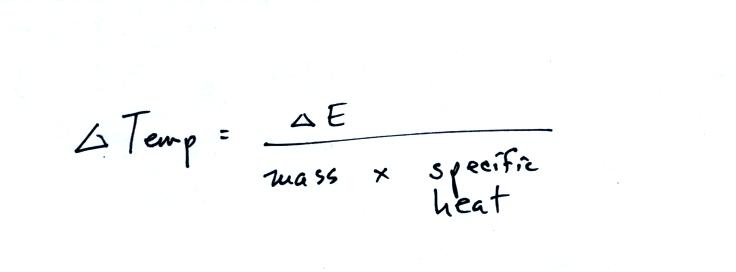
Here's that equation again. Now replace the energy term in this
equation with the energy term from the other equation.

You can either measure or look up every term in this equation except
for S.
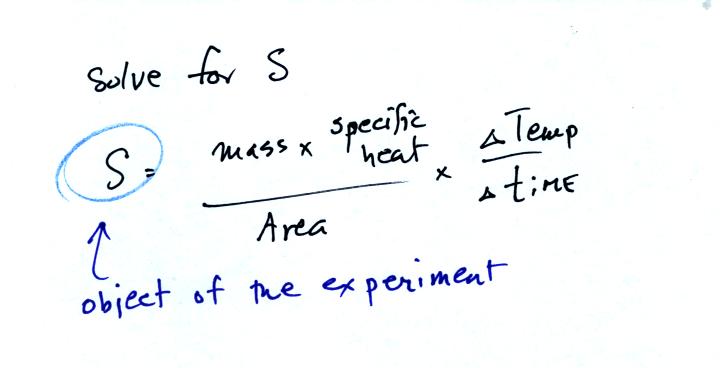
The object of the solar irradiance experiment is to measure the solar
irradiance, i.e. the energy in sunlight. You place a small block
of aluminum outside in the sun and measure how quickly it warms
up. You are given values for the mass and specific heat of the
block and you can easily measure it's area.





 The relative
humidity tells you how "full" the air is with water
vapor.
In the analogy 4 students wander into Classroom A which has 16 empty
seats. Classroom A is filled to 25% of its capacity.
You can think of 4, the number of students, as being
similar to the mixing ratio. The classroom capacity is analogous
to the
saturation mixing ratio. Instead of students and a classroom you
could think of a kilogram of warm air that could potentially hold 16
grams of water vapor.
The relative
humidity tells you how "full" the air is with water
vapor.
In the analogy 4 students wander into Classroom A which has 16 empty
seats. Classroom A is filled to 25% of its capacity.
You can think of 4, the number of students, as being
similar to the mixing ratio. The classroom capacity is analogous
to the
saturation mixing ratio. Instead of students and a classroom you
could think of a kilogram of warm air that could potentially hold 16
grams of water vapor. 












